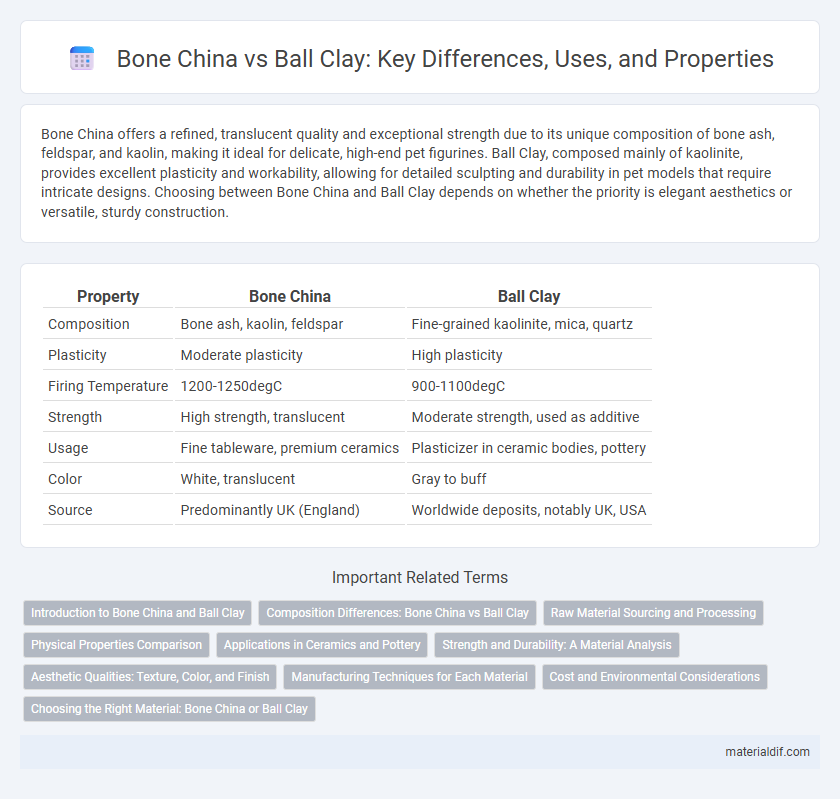Bone China offers a refined, translucent quality and exceptional strength due to its unique composition of bone ash, feldspar, and kaolin, making it ideal for delicate, high-end pet figurines. Ball Clay, composed mainly of kaolinite, provides excellent plasticity and workability, allowing for detailed sculpting and durability in pet models that require intricate designs. Choosing between Bone China and Ball Clay depends on whether the priority is elegant aesthetics or versatile, sturdy construction.
Table of Comparison
| Property | Bone China | Ball Clay |
|---|---|---|
| Composition | Bone ash, kaolin, feldspar | Fine-grained kaolinite, mica, quartz |
| Plasticity | Moderate plasticity | High plasticity |
| Firing Temperature | 1200-1250degC | 900-1100degC |
| Strength | High strength, translucent | Moderate strength, used as additive |
| Usage | Fine tableware, premium ceramics | Plasticizer in ceramic bodies, pottery |
| Color | White, translucent | Gray to buff |
| Source | Predominantly UK (England) | Worldwide deposits, notably UK, USA |
Introduction to Bone China and Ball Clay
Bone china is a type of porcelain known for its high strength, whiteness, and translucency, made from a mixture of bone ash, feldspar, and kaolin. Ball clay is a highly plastic fine-grained clay used primarily as a key ingredient in ceramics and pottery for its excellent plasticity and binding properties. While bone china emphasizes aesthetic qualities and durability, ball clay contributes to the workability and structural integrity of ceramic bodies.
Composition Differences: Bone China vs Ball Clay
Bone China consists primarily of bone ash, kaolin, and feldspathic material, giving it a translucent quality and high strength. Ball Clay is composed mainly of kaolinite, mica, and quartz, providing plasticity and workability for shaping ceramics. The key compositional difference lies in Bone China's high bone ash content, which enhances translucency and whiteness, while Ball Clay's mineral content imparts plasticity and firing shrinkage control.
Raw Material Sourcing and Processing
Bone China and Ball Clay differ significantly in raw material sourcing and processing methods. Bone China combines refined clay with bone ash sourced from animal bones, creating a translucent, durable ceramic through high-temperature firing. Ball Clay consists primarily of naturally occurring kaolinite and mica, mined from sedimentary deposits and processed with minimal additives to enhance plasticity and strength in ceramic production.
Physical Properties Comparison
Bone china exhibits superior translucency and higher strength due to its unique composition of bone ash, feldspar, and kaolin, resulting in a lighter, more delicate appearance compared to other ceramics. Ball clay is denser and more plastic, providing excellent moldability and workability with fine particle size and high plasticity, which enhances forming processes but lacks the translucency and strength of bone china. The physical properties of bone china yield a durable yet elegant final product, while ball clay's characteristics make it ideal for shaping and structural support in ceramic manufacturing.
Applications in Ceramics and Pottery
Bone China features high whiteness, translucency, and strength, making it ideal for fine tableware and decorative ceramics. Ball Clay offers excellent plasticity and workability, commonly used in pottery bodies and as a binder in casting slips. Both clays serve distinct purposes: Bone China for premium wares requiring durability and aesthetic appeal, Ball Clay for structural integrity and shaping ease in functional ceramic products.
Strength and Durability: A Material Analysis
Bone china exhibits superior strength and durability compared to ball clay due to its unique composition, which includes bone ash that enhances toughness and resistance to chipping. Ball clay, primarily composed of kaolinite, offers plasticity and workability but has lower mechanical strength and is more prone to cracking under stress. This material analysis highlights bone china as the preferred choice for high-strength ceramics requiring both resilience and aesthetic appeal.
Aesthetic Qualities: Texture, Color, and Finish
Bone China offers a smooth, translucent texture with a creamy white color and a glossy, lustrous finish that enhances delicate detailing. Ball Clay presents a plastic, fine-grained texture with a versatile gray to cream color spectrum, contributing to a matte or semi-matte finish depending on firing techniques. The aesthetic appeal of Bone China emphasizes elegance and translucency, while Ball Clay supports varied surface treatments and robustness in ceramic artistry.
Manufacturing Techniques for Each Material
Bone China and Ball Clay differ significantly in manufacturing techniques due to their unique compositions. Bone China incorporates bone ash, feldspar, and kaolin, requiring precise mixing and high-temperature firing around 1250degC to achieve its translucent, durable quality. Ball Clay involves a higher organic content, necessitating thorough de-watering and blending processes before firing at lower temperatures near 1100degC, resulting in a plastic, fine-grained material ideal for shaping and glazing.
Cost and Environmental Considerations
Bone china, composed primarily of bone ash, is generally more expensive than ball clay due to its refined materials and complex manufacturing process, resulting in higher production costs. Ball clay, a fine-grained sedimentary clay, offers a cost-effective alternative with widespread availability and lower environmental impact, as its extraction requires less energy and produces fewer emissions. In terms of sustainability, ball clay's abundant supply and simpler processing make it a more eco-friendly choice compared to the resource-intensive and energy-demanding production of bone china.
Choosing the Right Material: Bone China or Ball Clay
Bone China offers exceptional translucency, strength, and a smooth, white finish due to its high bone ash content, making it ideal for fine tableware and decorative items. Ball Clay, composed primarily of kaolinite, mica, and quartz, provides excellent plasticity and workability, making it essential for shaping and forming ceramics with durability and flexibility. Selecting Bone China or Ball Clay depends on whether the priority is aesthetic quality and delicacy or moldability and structural support in ceramic production.
Bone China vs Ball Clay Infographic

 materialdif.com
materialdif.com